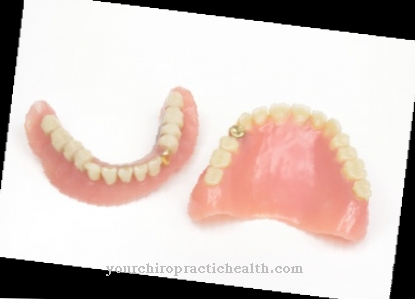A ceramic inlay is a dental filling made in the laboratory. This consists of more resilient and break-proof Ceramics. It is mainly used to treat teeth that have been damaged by tooth decay. Compared to composite fillings, it is more durable and can hardly be distinguished from healthy tooth substance.
What is ceramics?

Ceramic inlays are dental filling materials that are usually used to treat the consequences of dental caries in the posterior teeth. These are also used to treat tooth defects that have arisen due to trauma. They are therefore used to restore damaged teeth.
The inlay is an inlay filling that represents an alternative to the other known inlay fillings made of gold. In contrast to plastic filling materials (amalgam, composite, cement), they are not made directly in the mouth, but in a dental laboratory. To do this, the laboratory relies on an impression of the teeth, which is preceded by the removal of destroyed (carious) tooth substance.
The ceramic inlay combines the advantages of the other common fillings. The ceramic inlay has durability in common with the gold filling, although the average durability of gold is somewhat higher. With composite and cement fillings, the ceramic filling has in common that it can hardly be distinguished from healthy tooth substance.
The cost of a ceramic filling depends on the size of the defect, but also on other dental treatment costs. Usually the costs are between 300 and 700 euros per inlay.
Shapes, types & types
Ceramic inlays are made in the laboratory. There are different manufacturing processes available, which offer various advantages and disadvantages: In the sintering process, ceramic is applied in layers to a model stump made of refractory material and sintered under high pressure and temperature. The technician must take into account that the material will shrink during sintering. The possibility of color layering enables optimal aesthetic results to be achieved.
There is also the pressing process. A refractory hollow form is made and filled with tough ceramic mass under high pressure and then fired. After firing, a layer of ceramic paint is sintered on for coloring. The inlay has great stability because it is homogeneous and has no porosity. However, when grinding in, the layer of ceramic paint can be removed.
Computer-aided procedures are also used, some in the dental practice. A precisely fitting inlay is ground from a ceramic block using a 3-D recording. These are individualized by firing on ceramic paint.
Structure & functionality
A tooth does not heal on its own. For this reason, external intervention is required. The ceramic inlay should restore the function and shape of the tooth as best as possible.
First of all, the filling should close the hole caused by tooth decay and drilling so that the tooth nerve is protected and the tooth gains stability. If the hole were not closed, the tooth would break within a short time. Furthermore, an optimal chewing function should be ensured.
In addition to the functional factors, the aesthetic or optical factor also plays a major role. The ceramic inlay can hardly be distinguished from healthy tooth substance by means of tooth-like coloring.
The manufactured inlays are glued to the tooth in the patient's mouth. This is usually done using a rubber dam. This prevents saliva or moisture from reaching the tooth. The seating of the ceramic filling is checked before insertion. The tooth is then cleaned with special polishing pastes. Etching gel is applied when the tooth is clean and dry. The etching gel is used to enlarge the surface of the adhesive surface. Finally the glue is applied. As a rule, this is a two-component adhesive. Before the inlay is inserted, the adhesive is pre-cured using a UV lamp. Then the inlay is inserted and light curing is continued. The two-component adhesive has the advantage that not fully hardened adhesive will harden over time.
The teeth are polished after hardening to minimize the surface area of the tooth. This means that bacteria that can cause tooth decay have less surface to attack.
You can find your medication here
➔ Toothache medicationMedical & health benefits
In the posterior region, special requirements are placed on a filling. Fillings must be able to withstand chewing pressure in this area. It is problematic to use cement or composite fillings here. Over time, these can become leaky due to the great load. This can lead to secondary caries that must be treated. This in turn causes the tooth to lose tooth substance.
Inlays are much more resilient than plastic filling material, optimally seal the tooth and give it long-term stability. This is gentle on the tooth and protects against premature tooth loss. Investing in a ceramic inlay can therefore pay off over time.
In contrast to cement fillings and composites, an amalgam filling also has a longer service life. However, it should be taken into account that amalgam consists in parts of the toxic substance mercury. This is mixed with the metals silver, tin, copper and zinc. Although the mercury is chemically bound after the filling has hardened, mercury can be released and absorbed over time. For example, through abrasion when chewing or when removing amalgam fillings. When choosing a ceramic inlay, these substances are not relevant.

















.jpg)



.jpg)

.jpg)




